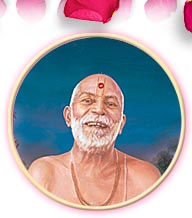|
Yogiji Maharaj’s visit gave immense happiness and satisfaction to the devotees in Africa and England. He returned to India after spending a total of five months abroad. English, Hindi, Marathi, Gujarati and other newspapers in India commended his spiritual tour. Everywhere people sang his praises. He was given a grand reception in Mumbai at the Shanmukhanand Hall, the largest auditorium in Asia. He was felicitated for his work and achievements. Swami Chinmayanand who presided at the function said, “While Indian youths imitate Western culture, this great sadhu at the age of 80 went abroad to promote the Hindu Dharma. He deserves acclaim for imparting moral and spiritual values to all.”
A public reception on the same scale was also accorded to him at Vadodara.
In Amdavad, then the capital of Gujarat, Yogiji Maharaj was taken in a grand procession through the main roads of the city. Yogiji Maharaj was the centre of attraction in the mile-long procession, where some five to six hundred thousand people turned up to have his darshan. In the city’s Tagore Hall, the Chief Minister of Gujarat, Shri Hitendrabhai Desai, and other ministers and spiritual heads paid their glowing respects and tributes to him. The Chief Minister, Shri Hitendrabhai Desai, said, “To honour Yogiji Maharaj is to honour a true adherent of Indian civilization. To honour Yogiji Maharaj is to honour the liberator of the whole of mankind. Today, we greet Yogiji Maharaj as the real giver of peace, one who dissolves the miseries caused by the many unpleasant incidents taking place in India and abroad.”
He was given a rousing reception at many other places, such as, Limdi, Gadhada, Bhavnagar, Mahuva, Amreli, Rajkot and Gondal.
Despite all these honours, Yogiji Maharaj never forgot to offer devotion to his guru and his other duties. On his last visit to Sarangpur he performed arti of the golden sinhasans (on the mandir sanctum) prepared for Shriji Maharaj. This was a highly cherished desire of Shastriji Maharaj, and it was at last fulfilled.
Despite the heavy rains in Bhavnagar, he came out to lay the foundation stone of the new mandir. In Mahuva he performed the murti-pratishtha ceremony in the mandir built at the birthplace of Bhagatji Maharaj, who was the guru of Shastriji Maharaj.
He then went to Gondal, where he stayed for three months. During this period in Gondal on the auspicious occasion of Sharad Purnima, he consecrated a beautiful marble murti of Shastriji Maharaj placed on a fine marble platform behind the Akshar Deri. He stayed in Gondal and pleased everyone. He invited the devotees there, and showered his divine blessings upon them. He celebrated many small and big festivals, giving precious memories to the devotees.
Then, all of a sudden, he decided to invite illness. It is not always possible to understand the actions of such godly sadhus. His illness worsened. Swami was immediately flown to Mumbai for further treatment. But, on 23 January 1971 (Posh vad 11, V.S. 2027) at 1.00 pm, he bid ‘Jai Swaminarayan’ to all, and left this world for Akshardham. The whole Satsang became overwhelmed with grief and shock.
His body was flown to Gondal. There, on 24 January 1971 (Posh vad 12) , after all the funeral rites were over, the body was cremated in the compound to the right of Akshar Mandir. Thousands of devotees from India and abroad offered their last tearful homage to Yogiji Maharaj.
To commemorate the spot where Yogiji Maharaj was cremated, Pramukh Swami Maharaj inspired a memorial shrine called Yogi Smruti Mandir.
|









